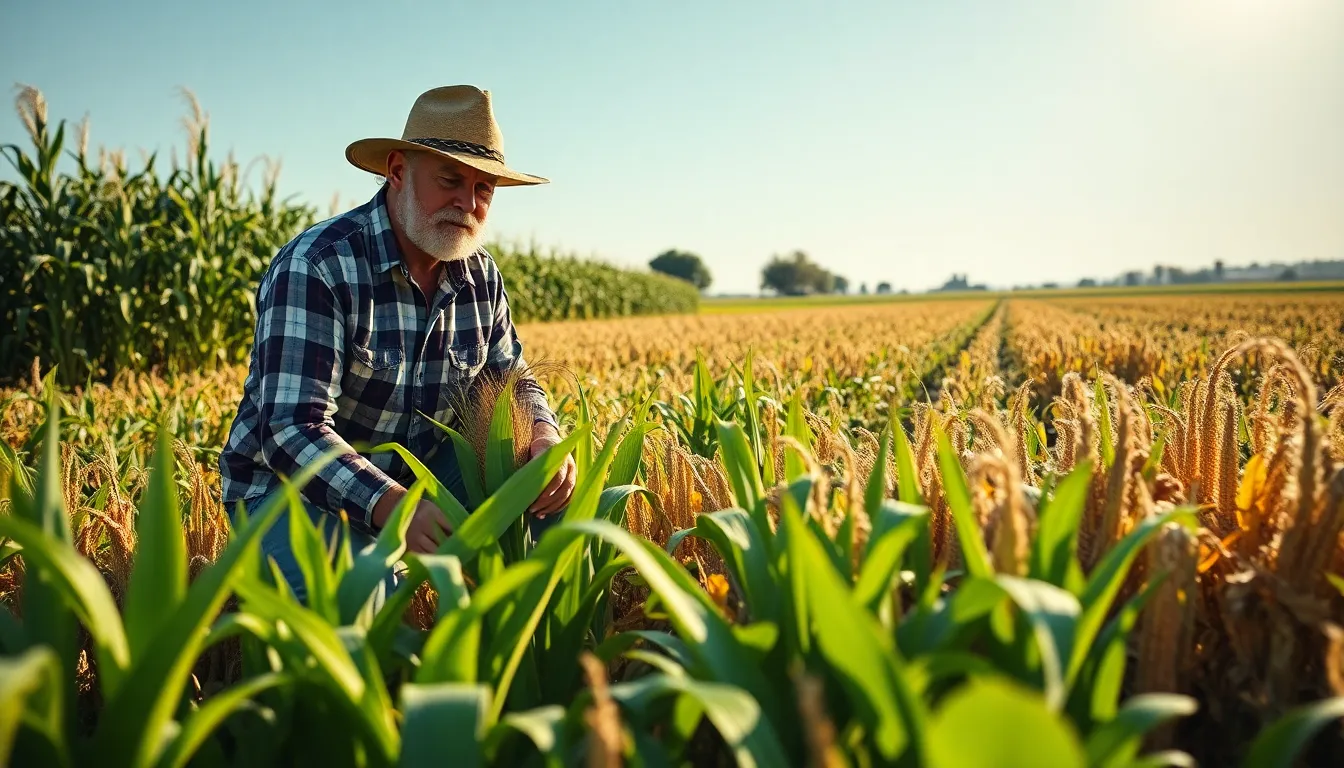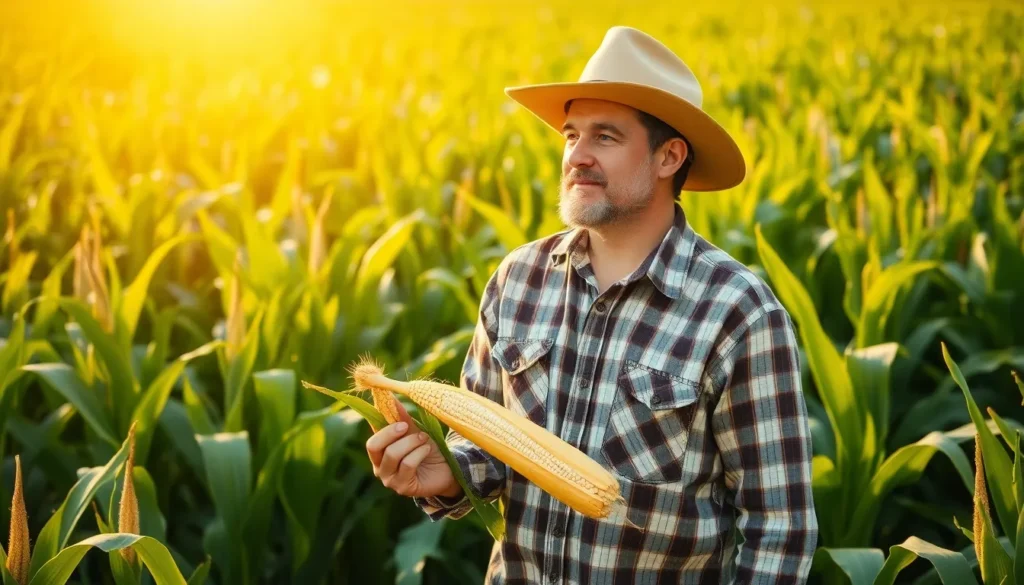Table of Contents
ToggleAgricultural economics might sound like a snooze-fest, but it’s the secret sauce behind the world’s food supply and rural development. Ever wondered how a simple corn kernel can impact global markets? This field dives deep into the numbers, policies, and trends that shape everything from farm profits to dinner plates.
Overview of Agricultural Economics
Agricultural economics examines the relationship between agriculture, economy, and the environment. It analyzes how agricultural production methods, market demands, and economic policies influence the food supply. Understanding these interactions helps in crafting effective policies and strategies that promote sustainable farming.
Farm management, a key aspect of agricultural economics, focuses on optimizing resource use. It includes labor costs, land management, and technology adoption. Applying economic principles in farm management increases efficiency and profitability for producers.
Market analysis plays a vital role in agricultural economics. Evaluating supply and demand dynamics assists stakeholders in anticipating price changes. Economic data, such as crop yields and export rates, provides insight into market behavior.
Policy development is another critical component. Policymakers rely on research to create regulations that support rural development. Agricultural policies can impact everything from subsidies to trade agreements, affecting farm income and consumer prices.
Another essential element involves food security. Agricultural economists analyze factors that impact food availability, accessibility, and utilization. Food security initiatives significantly reduce the vulnerability of populations to food shortages.
Environmental considerations also factor into agricultural economics. Sustainable practices can mitigate negative impacts on natural resources. Balancing economic viability with ecological health remains a pressing challenge for the field.
Cross-disciplinary collaboration enhances agricultural economics. Engaging with environmental science, sociology, and technology fields enriches the understanding of agricultural challenges. Integrating diverse perspectives fosters innovative solutions to complex agricultural issues.
Key Concepts in Agricultural Economics

Understanding agricultural economics includes grasping its foundational concepts, essential for analyzing the agricultural sector’s complexities. Key components involve supply and demand dynamics and various market structures influencing pricing strategies.
Supply and Demand in Agriculture
Supply and demand significantly affect agricultural outcomes. When crop yields increase, supply often rises, which can lead to lower prices if demand remains unchanged. Weather conditions and technological advancements can shift supply curves unpredictably. Demand for agricultural products hinges on consumer preferences, income levels, and global market trends. Inelastic demand can create scenarios where consumers continue to purchase necessary food items, even amid rising prices. Overall, these interdependent factors make market predictions crucial for farmers and policymakers.
Market Structures and Pricing
Market structures in agriculture vary widely, impacting price formation and competition dynamics. Perfect competition exists when numerous small producers offer identical goods, ensuring that prices align closely with production costs. Conversely, monopolistic competition features product differentiation, influencing pricing strategies among firms. Oligopoly structures often consolidate market power among a few dominant players, affecting pricing through strategic pricing tactics. Agricultural economists analyze these structures to assess how market power influences supply chain efficiency and profitability for producers. Understanding these factors helps farmers adapt their strategies to market conditions effectively.
Importance of Agricultural Economics
Agricultural economics plays a pivotal role in ensuring food security and supporting rural development. Understanding this field enables stakeholders to make informed decisions that affect both the economy and the environment.
Impact on Food Security
Food security relies heavily on agricultural economics. It assesses supply and demand, analyzing how production costs shape the prices consumers pay. Fluctuations in crop yields can alter food availability, making it essential to monitor weather patterns and technological advancements. Research indicates that countries with strong agricultural policies experience lower food prices and greater accessibility. Agricultural economists evaluate market trends to anticipate shortages and surpluses, guiding interventions that ensure sufficient food supply. They also explore the implications of international trade on domestic markets, influencing food prices and availability.
Contributions to Rural Development
Rural development thrives through the insights offered by agricultural economics. This field emphasizes strategies that bolster income for farmers and enhance quality of life in rural areas. Investment in agricultural infrastructure directly leads to improved access to markets and services. Policies informed by economic analysis promote sustainable practices, increasing productivity while protecting natural resources. Agricultural economists provide essential guidance on effective resource management, helping rural communities adapt to economic changes. By fostering cross-disciplinary collaboration, they enable innovative solutions that tackle complex agricultural challenges. Strengthening local economies ultimately supports overall national growth and stability.
Contemporary Issues in Agricultural Economics
Contemporary agricultural economics faces several pressing challenges that can significantly impact the sector’s future.
Climate Change and Sustainability
Climate change poses considerable risks to agricultural production. Increased frequency of extreme weather events leads to unpredictable crop yields. Farmers experience higher costs due to the need for adaptive measures and resilient practices. Economic analyses increasingly emphasize sustainable farming methods as essential for long-term viability. Research indicates that implementing sustainable practices can improve productivity while maintaining environmental health. Investments in eco-friendly technologies promote soil conservation and optimize water use. As policymakers respond with greener regulations, transitioning toward sustainable agriculture becomes critical for food security.
Technological Advances in Agriculture
Technological innovations drastically reshape agricultural economics. Precision agriculture utilizes data analytics to enhance efficiency and reduce waste. This approach allows farmers to make informed decisions tailored to specific field conditions. Drones and sensors monitor crop health, improving management practices and yields. Automation and robotics streamline labor-intensive tasks, helping to lower production costs. Research demonstrates that adopting new technologies raises farm profitability and competitiveness in global markets. Moreover, digital platforms facilitate better access to market information, empowering farmers to navigate price fluctuations effectively.
Future Trends in Agricultural Economics
Sustainability will dominate future discussions in agricultural economics. As climate change intensifies, farmers are exploring practices that minimize environmental impact. Adopting regenerative agriculture can enhance soil health, strengthen biodiversity, and improve resilience against extreme weather.
Technological advancements are shaping the industry. Precision agriculture utilizes data analytics to optimize input use, increasing returns while reducing waste. Automation technologies, like drones and robotics, streamline labor demands, offering efficiency for various farm operations.
Market dynamics will also evolve. Consumer preferences increasingly favor locally sourced and organic foods, impacting demand patterns. Agricultural economists are tasked with analyzing these shifts to inform producers about emerging opportunities and challenges.
Policy influence remains critical. Governments and organizations will prioritize regulations that support sustainable practices and food security initiatives. While developing supportive policies, agricultural economists must ensure that local economies benefit alongside environmental goals.
Global trade relationships will undergo transformation. As nations navigate supply chain vulnerabilities, they may reassess trade agreements affecting agricultural imports and exports. Understanding these changes helps stakeholders strategize for future market conditions.
Collaboration between disciplines will foster innovative solutions. Agricultural economists will work with environmental scientists, technologists, and policymakers to address complex agricultural challenges. Combining insights enhances resource management approaches, promoting economic viability alongside ecological health.
Agricultural economics plays a vital role in shaping the future of food production and rural development. As challenges like climate change and shifting consumer preferences emerge, the field’s importance only grows. Embracing sustainability and innovative practices will be key for farmers aiming to thrive in a changing market.
The collaboration between agricultural economists and other disciplines fosters solutions that address both economic and environmental concerns. By staying informed on market dynamics and policy influences, stakeholders can navigate the complexities of this essential sector. Ultimately, a commitment to sustainable practices and cross-disciplinary approaches will ensure a resilient agricultural economy that meets the needs of future generations.







